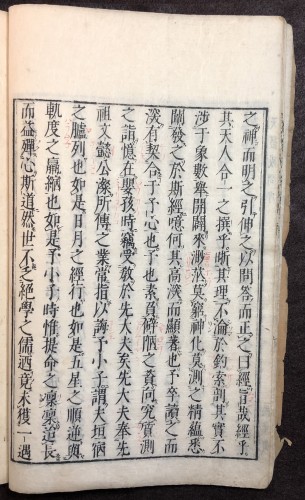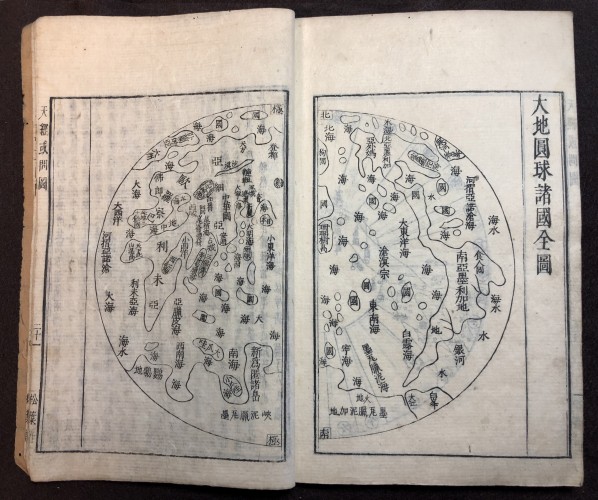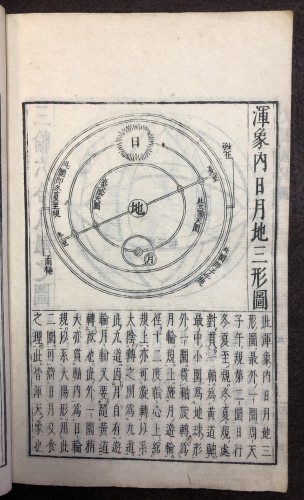Guest post by Liangyu Fu, Chinese Studies Librarian, Asia Library, University of Michigan Library
The Special Collection Research Center recently acquired an early Japanese astronomy book titled 天経或問 (Japanese: Tenkei wakumon; Chinese: Tianjing huowen: "Questions and Answers on Astronomy"). Printed in 1730 in Tōkyō, it was a republication of a Chinese astronomy work supplemented with Japanese reading marks. From within the book and beyond the page, we can see that this work richly illustrates an episode of dissemination of Western astronomical knowledge in China, as well as the intellectual exchanges that took place between China and Japan through the book trade and reprinting.
The Book Itself
This version of Tenkei wakumon contains three volumes, each of which has approximately one hundred pages. Bibliographically this book is made in the traditional East-Asian style, meaning that everything appears in reverse to the way an average Western book would appear, including the presentation of the text, the page sequencing, and the direction in which pages are to be turned. The title page presents the publication information of the original Chinese book, which was written and compiled by You Yi 游藝 (courtesy name 子六, 1614?-1684?), a Chinese intellectual and astronomer influenced by Western learning, and examined by Fang Yizhi 方以智 (courtesy name 密之, 1611-1671), a renowned Chinese scholar and philosopher. The book was printed with woodblocks carved by Kōzanbō 嵩山房 in Tōkyō.

Title page of 天経或問 (Japanese: Tenkei wakumon; Chinese: Tianjing huowen). Tōkyō: 1730
This Japanese reprint is all in Chinese characters to emulate the original Chinese edition. But in addition, reading marks were provided by the Japanese astronomer Nishikawa Seikyū 西川正休 (1693-1756, biographical notes in Japanese) to aid the reading process of contemporary Japanese readers. In addition and curiously, an anonymous reader left traces on the pages by taking some notes in red brush pen.

Japanese reading marks and an anonymous reader’s notes. The reading marks are the small symbols, mainly indicating Japanese pronunciation, printed adjacent to the Chinese characters.
Volume One features an extensive series of front matter, as well as the illustration section. It begins with a preface to this Japanese reprint version, another prefatory piece known as a fanli 凡例 (hanrei in Japanese), and additional prefaces to the Chinese original. Following them is an extended list of astronomers in China from the ancient period until the late Ming dynasty (1368-1644). Besides native Chinese astronomers, it also lists ten renowned European Jesuit missionaries (e.g., Matteo Ricci 利瑪竇, Johann Adam Schall von Bell 湯若望, Giacomo Rho 羅雅谷) who worked in China and had various connections to the emperors’ court. The inclusion of Jesuits’ names demonstrates You Yi’s recognition of Western contributions to astronomy in China. Toward the end of the front matter section are a list of works referenced in the book and a table of contents.

List of works referenced
The illustration section features a variety of maps and images of astronomical tools. There are nine half-page illustrations with textual explanations beneath them. Most of them depict the relationships among the sun, the moon, and the earth; solar and lunar eclipses; time zones of the earth; and contemporary astronomical equipment. Following them are ten illustrations, each of which covers a full spread. They are mainly celestial maps, as well as a map of the world and a map of China.

The map of the world
Many of the illustrations accurately demonstrate the Western influence on Chinese cosmology and worldview. For example, although the heliocentric theory was already being debated in Europe during the 17th century, Jesuits remained strong advocates for the geocentric model and conveyed that knowledge system to China. Multiple illustrations in this book show the earth positioned as the center of the universe. Another example of the Western impact is that the earth is depicted as a round object in this book. By the mid-to-late 17th century, the concept of a spherical earth was only nascent in China, and the mainstream still subscribed to the idea of a flat earth (Chen and Chen, 2000). However, we can see that this book visually reinforces the view of a spherical earth.

Orbits of the earth, the sun, and the moon, with the earth as the center

Different time zones on the earth, which further confirms the concept of a spherical earth
Volume Two and Volume Three are organized by topic and written in Q&A format. A wide range of topics are covered, mostly astronomical phenomena in Volume Two and meteorological and geological phenomena in Volume Three. Not everything in these volumes concerns the basics of Western astronomy that Jesuits brought to China. A handful of entries also involve traditional Chinese religious and philosophical beliefs. For example, toward the end of Volume Three, the reincarnation of stars and humans is explained.
Beyond the Page
We have already seen that the pages of this book carry rich information. But when situated in the history of the book in East Asia and the history of astronomy in Japan, these three thin volumes tell us even richer stories.
A quick glance at book history in China and Japan, ca. 1630-1730
You Yi, the author of the original Chinese book, lived in the late Ming (1368-1644) and early Qing (1644-1912) era. This era witnessed not only a drastic dynastic shift, but also an unprecedented flourishing of commercial publishing in terms of market size, diversity of the types of texts, and the scope of distribution networks. Commercial publishers began to be active at least as early as the 12th century, but it was not until the 16th century that widespread commodification of writing and production helped disseminate printed texts to a broad range of social classes (Brokaw and Chow, 23-24). Consequently, the price of books became fairly affordable even for readers of low income levels (Chow, 55-56).
The SCRC copy of Tenkei wakumon was published in 1730, right in the middle of the Edo period (1603-1876). The commodification of the book started around 1600 in Japan. It began a few centuries later than it had in China, but quickly become a trend throughout the Edo period. One can imagine that in 1730, many aspects of book production in Japan were subject to commercialization, including block carving, printing, and book distribution (Kornicki, 169).
Book trade and book ban
Many Chinese books on various topics were imported to Japan until the end of the 19th century. Although the quantity of those books was insignificant in comparison to the entire book market of Japan, the imports played “a fundamental role in the formation of Japanese book culture and intellectual enquiry” (Kornicki, 277 and 299).
Tenkei wakumon exemplifies a historical episode of Sino-Japanese knowledge exchange in book form. The book trade certainly enabled copies of You Yi’s original to reach Japan, thus making possible the later publishing of Tenkei wakumon. However, the process was full of twists and turns. From 1630 to 1720, the shogunate government issued a strict ban on the importation of Christianity-related books. This policy applied not only to everything written in Chinese by European missionaries, but also to all Chinese writings that had Christian content (Boot, 195). You Yi’s original book in fact had two parts, but only the first successfully entered Japan. The second part included scattered mentions of Christianity, therefore it was banned during the prohibition (Mercer, 194). Japanese readers at that time never had the chance to experience the entirety of You Yi’s Tianjing huowen.
The impact of Tenkei wakumon in Japan
Curiously, You Yi’s Tianjing huowen and its Japanese version Tenkei wakumon lived dramatically different afterlives. In China, Tianjing huowen generally lacked popularity. It was not at all a mainstream text in the history of astronomy, nor a regular reference in the historiography of astronomy. However, Tenkei wakumon was highly influential in Japan.
You Yi’s original was imported to Japan sometime between 1672 and 1679. Nishikawa Joken (1648-1724), an important Japanese astronomer, was probably the first person to read it. You Yi’s text represented a watershed in the field of astronomy in Japan. For example, Shibukawa Harumi (1639-1715) incorporated the European knowledge of astronomy he acquired from it into the calendar reform he initiated during the Jōkyō era (1684-1688) (Tan, 2014). The book also greatly stimulated the spherical earth theory in the Japanese intellectual world (Mercer, 194) and aided Japanese astronomers in illustrating the previously unknown South Pole stars (Miyajima, 585). Before this book, Japanese astronomy books were primarily about horoscopes and calendars. But this was a more general introduction, appropriate for a much broader audience. In the 1730 version, Nishikawa Seikyū, Joken’s son, provided reading marks for and comments on the original book, making it even more popular (Watanabe, 1986, 40), and it soon became a must-read for astronomy enthusiasts (Watanabe, 1941, 210).
With its wide distribution and readership, Tenkei wakumon joined the forces pushing for the development of astronomy in Japan. Thus, despite the fact that at one time it became a target of Buddhist monks who labelled it as heresy--because the cosmology it introduced was irreconcilable with that of Buddhism (Watanabe, 1986, 41-42)--Tenkei wakumon still made a lasting impact on Japanese intellectual history, and editions of it and commentaries on it continued to be published for more than 100 years after its first appearance in Japan.
Additional Resources
- Reprinted versions of the Chinese original available at U-M Library (e.g., the reprint from a manuscript version and volume 6 of this set)
- One preface to the copy at SCRC indicates that it is a combination of both the main text of Tenkei wakumon and an appendix titled 天學名目鈔 (Tengaku myōmokushō, by Nishikawa Seikyū). However, the appendix section is not seen in this copy. Here is the digital replica of a version with a separate volume of the appendix, located at Keio University. Tengaku myōmokushō was published as a single volume as early as 1729.
- Example of a Japanese reprint located at Waseda University also with prefaces dated in 1730
- Example of an annotated edition of Tenkei wakumon
References
Boot, W. J. “The Transfer of Learning: The Import of Chinese and Dutch Books in Tokugawa Japan.” Itinerario 37.3 (2013): 188-206.
Brokaw, Cynthia, and Kai-wing Chow, eds. Printing and Book Culture in Late Imperial China. Berkeley: University of California Press, 2005.
Chen, Meidong 陈美东, and Chen Hui 陈晖. “Mingmo Qingchu xifang Diyuanshuo zai Zhongguo de chuanbo yu fanxiang 明末清初西方地圆说在中国的传播与反响 [Dissemination and Repercussions of the Idea of a Spherical Earth in China from Late Ming to Early Qing].” Zhongguo keji shiliao 中国科技史料 [Chinese Historical Materials of Science and Technology] 21.1 (2000): 6-12.
Chow, Kai-wing. Publishing, Culture, and Power in Early Modern China. Stanford: Stanford University Press, 2004.
Kornicki, Peter. The Book in Japan: A Cultural History from the Beginning to the Nineteenth Century. Leiden: Brill, 1997.
Liu, Jia 刘佳. “You Yi de tianwenxue sixiang yu yuzhou moxing chutan 游艺的天文学思想与宇宙模型初探 [Preliminary Study of You Yi’s Astronomy Thought and Model of the Universe].” MA Thesis, Donghua University, 2013.
Mercer, Rosemary. Deep Words: Miura Baien’s System of Natural Philosophy. Leiden: E.J. Brill, 1991.
Miyajima, Kazuhiko 宮島一彦. “Japanese Celestial Cartography before the Meiji Period.” In The History of Cartography, Volume 2, Book 2, edited by J. B. Harley and David Woodward, 579-603. Chicago: University of Chicago Press, 1994.
Tan, Wei Yu Wayne. “Science, Politics and Networks: Shibukawa Harumi and the Birth of the New Almanac in Seventeenth-century Japan.” Annals of Science 71:2 (2014): 241-70.
Watanabe, Toshio 渡邊敏夫. “Tenkei wakumon to Edo jidai chūki no tenmongaku 天經或問と江戶時代中期の天文學 [Tenkei wakumon and Astronomy in the Mid-Edo Period].” Tenkai 天界 [The Heavens] 21.241 (1941): 208-12.
Ibid. Kinsei Nihon tenmongakushi 近世日本天文学史 [History of Astronomy in Early Modern Japan]. Tōkyō: Kōseisha Kōseikaku, 1986.
Acknowledgment:
The author would like to thank Kazuko Anderson for her help with Japanese resources and Dawn Lawson for her editorial assistance.
Liangyu Fu (Chinese Studies Librarian, Asia Library, University of Michigan Library)